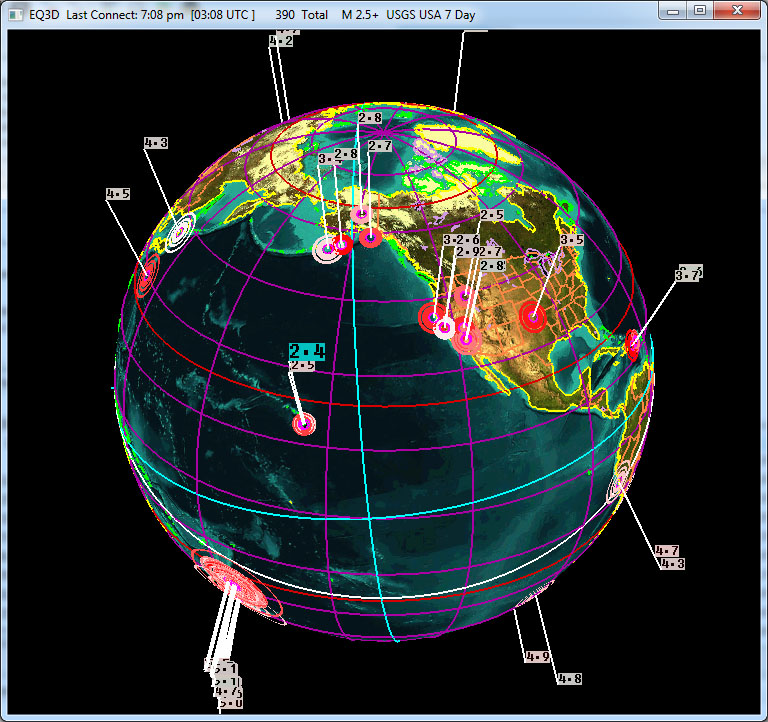

Screenshot of a DEM over a portion of the fault rupture with preliminary hand-digitization of visible scarps ( credit: Kenneth Hudnut , USGS) overlain on Google Earth Imagery. Browser-based 3D point cloud visualization from OpenTopography. The 3D geologic model of the Hayward fault (Graymer et al., 2005 Phelps et al., 2008) and the USGS 3D Geologic Model of the San Francisco Bay Area (subsequently referred to as the Big Bay Model) (Jachens et al., 2006) provide a picture of the 3D geometry of the Rodgers Creek-Hayward-Calaveras-Northern Calaveras fault zone. Perspective view over the Trona Pinnacles. Fault rupture traces from Kendrick et al.

178ĭigital elevation model colored by elevation, with 0.5 m contours.
#USGS 3D EARTHQUAKE UPGRADE#
Download and Upgrade the Volcanoes & Earthquakes app to get one of. The data for this release is an ASCII file containing grid points of Cascadia P- and S-wave velocity models. EQ3D Real-time global earthquake monitor 3D map display.
#USGS 3D EARTHQUAKE ARCHIVE#
National Science Foundation (NSF EAR-1945781 & EAR-1945754), covering 293 km 2 of the region impacted by the 2019 Ridgecrest earthquake sequence in southern California. The datasets cover a portion of the main surface fault ruptures of both of the M 6.4 and M 7.1 Ridgecrest earthquake sequence, as well as the areas of non-tectonic ground deformation near Trona and Argus, CA including the fragile geological features called the Trona Pinnacles. Earthquake archive from 1900 onwards Detailed quake stats Additional seismic data sources. 3: USGS Feed: Detail: Tuesday December 7 Earthquakes are shown as circles sized by magnitude. Overall, our results highlight the importance of strong‐motion‐generating subevents for coastal sites, as well as the amplification of long‐period ground shaking in deep sedimentary basins, compared with previous scenario ShakeMaps for Cascadia.OpenTopography is pleased to announce the release of two new 2019 lidar datasets, collected by the National Center for Airborne Laser Mapping (NCALM) and funded by the U.S. In addition, 3D earthquake simulations capture important features such as strong ground‐motion amplification in the Pacific Northwest’s sedimentary basins, which are not well represented in the empirical GMMs that compose traditional scenario ShakeMaps. Whereas traditional scenario ShakeMaps are based on a single hypothetical earthquake rupture, our ensemble ShakeMaps take advantage of a logic‐tree approach to estimating ground motions from multiple earthquake rupture scenarios. Using this updated set of 30 M M 9 Cascadia earthquake scenarios, we present ensemble ShakeMaps for the median, 2nd, 16th, 84th, and 98th percentile ground‐motion intensity measures. 3D Visualization: Displaying Earth seismic activity in 3D space placed onto Earth 3D Model: Y: WF1: Function: Downloading data: Downloading data from USGS CSV feed with one-minute interval: Y: WF3: Function: Camera Controller: Camera Controller responsible for moving user view.

(2018) to cover all of Washington State, Oregon, northern California, and southern British Columbia to facilitate the use of these ensemble ShakeMaps in region‐wide risk assessments and scenario planning exercises. In addition, we use empirical ground‐motion models (GMMs) to expand the ground‐shaking estimates beyond the original model extent of Frankel et al. Here, we expand on this work by computing site‐specific amplification factors for the Pacific Northwest and applying these factors to the ground‐motion estimates derived from Frankel et al. Magnitude: 0.1 to 1.0 1.0 to 2.0 2.0 to 3.0 3.0 to 4.0 4.0 to 5.0 5.0 to 6.0 6. (2018) used a hybrid approach (i.e., 3D deterministic simulations for frequencies 1 Hz >1 Hz ) and uniform site amplification factors to create broadband seismograms from this set of 30 earthquake scenarios. Ground‐shaking estimates are based on 30 M M 9 Cascadia earthquake scenarios, which were selected using a logic‐tree approach that varied the hypocenter location, down‐dip rupture limit, slip distribution, and location of strong‐motion‐generating subevents. We develop ensemble ShakeMaps for various magnitude 9 ( M M 9) earthquakes on the Cascadia megathrust.


 0 kommentar(er)
0 kommentar(er)
